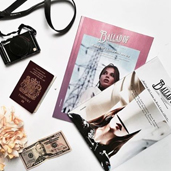Aitor Frías & Cecilia Jiménez Photography
by Lidia Costa on 30 June 2015
“The relation between what we see and what we know is never settled. Each evening we see the sun set. We know that the earth is turning away from it. Yet the knowledge, the explanation, never quite fits the sight.” These are words by John Berger in “Ways of seeing”, and which we can relate to the work of today’s Brand New Art We Heart: Aitor Frías & Cecilia Jiménez.
Aitor and Cecilia are two young photographers currently based in Granada, Spain. They started taking pictures together in Braunschweig, Germany in 2014, where they lived for a few months while pursuing their studies in architecture and science. Since then, they have been creating and exploring the unlimited possibilities of photography. Their work speaks for itself. It shows fragments, moments, images that resemble the jigsaw pieces of a puzzle, of which some parts are left for us to imagine and fill in the blanks.
Their work has been featured in magazines such as: New York Arts Magazine, Lunas Pasajeras and Morfae among others and you can find their work online in Snapwire and Photo Vogue. We had the opportunity to talk to them about art, their work, what inspires them... and here is what they told us!
First, we would like to know more about you. Could you tell us a bit about Aitor and Cecilia Photography? Who are you and what defines your work? We are two photographers very much interested in the collective imaginary, the memory that dwells in the subconscious of all of us thanks to globalization. It is a very powerful tool because it allows you to create images with a complex background without using a large number of elements, which is great because we love simple Photography, almost minimalist. What interests us is not just something beautiful that is happening right now, in front of our camera, but to what extent it has always happened -and will always happen-.
When did you start working together? How did it happen? We started working together a year ago, in the summer of 2014. Since we met in 2013 we had spent hundreds of hours talking about film, music, painting, literature and about art in general. Building theories together, proposing ideas and wondering how would it be bring them to reality. So one day we discovered, almost by chance, that photography was the perfect tool to express all these conclusions and own artistic theories. I guess the fact that it is a discipline on the intersection of all others what makes it so powerful. When you see a good movie there's always an image that is recorded on your retina or when you hear a song with a very dense atmosphere, It evokes to you a distant scene. Those involuntary images, which you cannot control because they come from the subconscious, are the photographs that we want to take.
When working as partners, do you have different roles or do you both work together in all aspects? As we said, our work is based on these conversations about Art that we constantly have, so the main part of our creative process can happen in a bar, in the kitchen while cooking or in the car. From there it comes the ideas that we late look for with the camera, where Cecilia normally takes the role of model, although sometimes we seek other models that can better adapt to certain ideas. In the post-production process the opinion of both of us is equally important.
Your work emphasizes detail and a fragmentation of what could be scenes. Would you say that there are some cinematic influences in your work? Are there any hidden messages in your photographs that you may want to share with us? That´s a good question. Indeed, we prefer to suggest rather than fully define the scene, let the viewer complete the story in their mind in an absolutely personal way. Our photographs try to evoke something beyond the image itself, as you say, but always showing the minimum so that the scene can be formed in the mind of the beholder. We are more interested in what is not told, is not seen, than in what is explicitly shown. Of course, there are many great filmmakers that have influenced us in that way of narrating, as Wim Wenders, Zhang Yimou or Tarantino. We love Film and we are planning to start an audio-visual project soon.
On your website, you make reference to photography as the "Art of Painting with Light" and you mention names of artists known for the use of light in their work. Are these artists and periods in art history, like the Renaissance, a point of reference for your work? Are there any other artists or photographers that influence your work? Exactly. For us the main ingredient in photography is light. You cannot tell a story without an interesting light, without an atmosphere that makes it credible, even a portrait. And we are fascinated by the use of light of the great masters of painting from periods as the Renaissance, Baroque and Impressionism. We continuously look at them trying to decipher their lighting schemes and use them in our work. In "The Potter and the Clay" for example, you can see references to the art of Michelangelo, Durero or Velazquez. Although, of course, we are also influenced by other photographers such as Laura Makabresku or Chema Madoz and by the photography of many films such as "Blade Runner" or "Ida". As self-taught Artists, our influences are very diverse. When we took the photograph "The Tree," for example, we were thinking of the words of the architect Louis Khan, who said that the first school of Humanity was a shade tree on top of a hill.
You have some of your work published in Photo Vogue. How did it feel when your work was accepted? When they accepted our first picture in Photo Vogue, it was a before and after for us. For the First time, we believed that our work could interest to someone beyond our friends and our family. It was important for us to know that our photographs had passed the filters of such an emblematic place for contemporary artistic photography as Photo Vogue.
We just launched our newest print issue and the theme for this issue is “the Muse”. Have you ever worked with someone that you both could consider your muse? In the short time we've been taking pictures we could experience that feeling that makes certain people become muses for you. Not everyone has what you're looking for at an artistic point of view and, of course, when you find someone you connect at an abstract level, you experience a delicious fascination. I guess that that feeling is where the term "Muse" comes from. Of course, Cecilia is the usual muse of Aitor Frías & Cecilia Jimenez Photography, but fortunately for us, we are finding some more on the way.
For more of Aitor and Cecilia, check out their website, Facebook, and Twitter.




